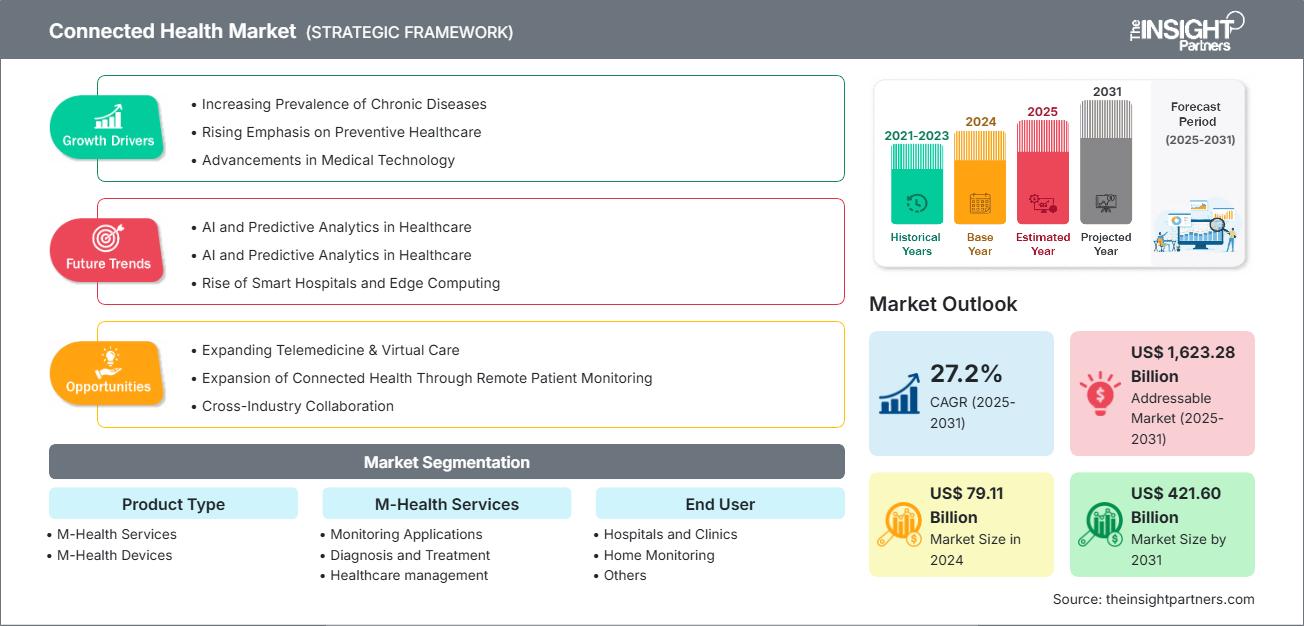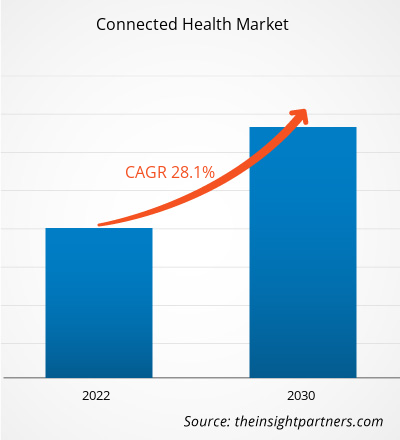[研究报告] 2022年,互联医疗市场规模达626.1亿美元,预计到2030年将达到4535.6亿美元。预计2022年至2030年期间,该市场的复合年增长率将达到28.1%。
市场洞察与分析师观点:
由于对价值的需求以及日益激烈的竞争环境,许多医疗机构正在寻找新的、更高效的方法来提升其提供的治疗质量。实现“随时随地”的患者与医疗服务提供者之间的连接是使服务更便捷、更经济的一种方式。互联医疗(cHealth)是一种由技术驱动的综合医疗服务提供系统,它能够实现远程诊断、治疗、监测和沟通。数字医疗的日益普及以及世界卫生组织 (WHO) 的“移动老龄化”计划等因素推动了互联健康市场的增长。
市场驱动因素:
数字医疗通过收集健康相关数据或医疗信息并向患者提供服务,使医疗保健实践更易于管理和简化。互联健康技术是一种支持治疗、慢性病管理和疾病监测的工具。由于生活方式的改变,包括心脏病、糖尿病和癌症在内的慢性病的发病率正在上升。对于需要持续监测的非传染性疾病患者,数字医疗在满足此类需求方面发挥着关键作用。在许多情况下,由于通过移动医疗技术进行远程监测以及通过数字工具和可穿戴设备进行数据评估,慢性病的管理发生了变化。除了将重点从急性和被动护理转移到主动和预防性护理之外,互联健康还改变了患者与医疗服务提供者和医疗保健系统的互动方式。技术的不断发展和应用,使得数字医疗更加经济实惠且便捷,从而促进了其普及。
信息技术的不断发展,推动了医疗行业的普及,并促进了全球互联医疗的快速发展。在移动医疗领域,移动电话、笔记本电脑和平板电脑等设备在扩大医疗保险覆盖率方面发挥着重要作用。由于移动技术的不断发展,政府和其他组织正在转向移动设备,以提高生产力,并注重整合其力量,以便及时使用现有的健康数据。先进技术的快速发展使得电子系统之间的数据信息共享更加便捷。日益增强的健康数据安全性有助于用户获得准确的数据,并帮助决策者提高关键决策的能力。因此,由于数字医疗的便捷访问和广泛的应用,大量的人可以使用它,这可能会推动互联医疗市场的增长。
预计医疗物联网 (IoMT) 的普及将在未来几年带来新的互联医疗市场趋势。
然而,许多医疗保健机构引入了导致个人健康数据泄露的风险,并且没有提供保护电子个人健康信息的指南。因此,使用这些服务所带来的威胁日益增加,这相应地加剧了健康数据安全问题,限制了互联医疗市场的发展。自定义此报告以满足您的要求
您将免费获得任何报告的定制,包括本报告的部分内容,或国家级分析、Excel 数据包,以及为初创企业和大学提供超值优惠和折扣
互联健康市场: 战略洞察

-
获取本报告的主要市场趋势。这个免费样本将包括数据分析,从市场趋势到估计和预测。
报告细分和范围:
“互联健康市场分析”通过考虑以下细分市场进行:类型、应用和最终用户。按类型,市场分为移动医疗服务和移动医疗设备。按应用,市场分为监测应用、诊断和治疗、医疗保健管理、健康和预防等。根据最终用户,市场分为医院和诊所、家庭监测等。
细分分析:
按类型,互联健康市场分为移动医疗服务和移动医疗设备。移动医疗服务细分市场在 2022 年占据了更大的市场份额;然而,移动医疗设备细分市场在 2022 年至 2030 年期间在互联健康市场中可能会实现更高的复合年增长率。互联医疗并非在医疗机构内部监控患者,而是更加注重远程数据传输和居家提供合适的医疗服务。除了能够远程提供医疗服务之外,互联医疗最大的突破在于其提供的海量数据。借助互联医疗服务,医生可以做出更明智的决策,并根据患者需求提供主动治疗。
根据应用领域,互联医疗市场细分为监测应用、诊断和治疗、医疗管理、健康与预防等。监测应用领域在2022年占据了最大的市场份额;然而,诊断和治疗领域很可能在2022年至2030年期间成为互联医疗市场中复合年增长率最高的领域。远程监测系统与物联网 (IoT)、数字传感器和大数据工具相结合,改善了患者的就诊体验,为专注于改善医疗服务提供开辟了新的机遇。在新冠疫情期间,这些系统的整合显著增加。健康远程监控系统 (HRMS) 具有诸多优势,包括减少医疗中心和医院的患者负担。
按最终用户划分,互联医疗市场可细分为医院和诊所、家庭监控和其他领域。2022 年,医院和诊所领域占据了互联医疗市场份额的主导地位。然而,预计家庭监控领域在 2022 年至 2030 年期间的复合年增长率最高。根据 OAE Publishing Inc. 的数据,2021 年,大约一半的美国医院都已实施某种形式的互联医疗,用于远程患者监控,约 80% 的欧洲国家已将远程医疗服务纳入其医疗保健服务之中。
区域分析:
互联医疗市场报告的范围主要分为北美(美国、加拿大和墨西哥)、欧洲(西班牙、英国、德国、法国、意大利和欧洲其他地区)、亚太地区(韩国、中国、印度、日本、澳大利亚和亚太其他地区)、中东和非洲(南非、沙特阿拉伯、阿联酋和中东和非洲其他地区)以及南美洲和中美洲(巴西、阿根廷和南美洲和中美洲其他地区)。
就收入而言,2022 年,北美占据了互联医疗市场份额的主导地位。预计亚太地区市场在 2022 年至 2030 年期间的复合年增长率最高。亚太市场正在蓬勃发展,这得益于国际企业在印度和中国不断增加的投资、CRO服务基础的拓展、医疗基础设施的进步以及政府支持力度的加强。此外,Apollo 于 2023 年在印度推出了“综合互联医疗计划”。该计划运用了 Apollo 先进的互联医疗技术。Apollo 的“综合互联医疗服务”将在印度全国范围内实施,使临床团队和护理人员能够在患者护理的每个阶段(包括居家护理、术后护理、住院护理以及急诊和救护车服务)获得全面、最新的患者信息。
互联健康市场区域洞察
The Insight Partners 的分析师已详尽阐述了预测期内影响互联医疗市场的区域趋势和因素。本节还讨论了北美、欧洲、亚太地区、中东和非洲以及南美和中美洲的互联医疗市场细分和地域分布。
互联健康市场报告范围
| 报告属性 | 细节 |
|---|---|
| 市场规模 2024 | US$ 79.11 Billion |
| 市场规模 2031 | US$ 421.60 Billion |
| 全球复合年增长率 (2025 - 2031) | 27.2% |
| 历史数据 | 2021-2023 |
| 预测期 | 2025-2031 |
| 涵盖的领域 |
By 产品类型
|
| 覆盖地区和国家 |
北美
|
| 市场领导者和主要公司简介 |
|
互联健康市场参与者密度:了解其对业务动态的影响
互联医疗市场正在快速增长,这得益于终端用户需求的不断增长,而这些需求的驱动因素包括消费者偏好的不断变化、技术进步以及对产品优势的认知度不断提高。随着需求的增长,企业正在扩展其产品线,不断创新以满足消费者需求,并抓住新兴趋势,从而进一步推动市场增长。

- 获取 互联健康市场 主要参与者概述
竞争格局和重点公司:
互联医疗市场报告重点关注市场中的知名企业,例如 Athena Health、AgaMatrix、AirStrip、AliveCor Inc、Allscripts Healthcare LLC、Apple Inc、NXGN Management LLC、Cerner Corporation、Cognizant 和 Honeywell International Inc.。互联医疗市场预测可以帮助利益相关者规划增长战略。这些公司专注于新技术、升级现有产品和市场扩张,以满足全球日益增长的消费者需求。
- 2023 年 12 月,GE HealthCare 与 AirStrip 签署了联合商业化协议。 GE HealthCare 成为 AirStrip 心脏病学和患者监测解决方案在美国的独家经销商,为医疗保健系统提供数据可视化技术。
- 2023 年 1 月,BioIntelliSense 与 care.ai 合作,将 BioIntelliSense 的高频生命体征趋势数据和基于算法的警报功能整合到 care.ai 的环境监测工作流程中。此次合作将这些变革性技术的互补能力结合起来,以提高患者满意度、优化临床运营,并直接应对负担过重的医护人员面临的关键挑战。
- 历史分析(2 年)、基准年、预测(7 年)及复合年增长率
- PEST和SWOT分析
- 市场规模、价值/数量 - 全球、区域、国家
- 行业和竞争格局
- Excel 数据集
近期报告
客户评价
购买理由
- 明智的决策
- 了解市场动态
- 竞争分析
- 客户洞察
- 市场预测
- 风险规避
- 战略规划
- 投资论证
- 识别新兴市场
- 优化营销策略
- 提升运营效率
- 顺应监管趋势






















 获取免费样品 - 互联健康市场
获取免费样品 - 互联健康市场